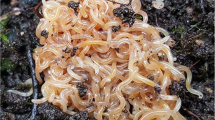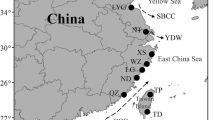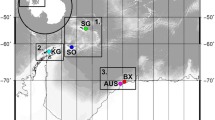Abstract
This paper is the first to address the suitability and potential of the cytochrome oxidase-1 (CO1) region of the parasitic marine nematode Anisakis simplex sensu stricto as a genetic marker. A. simplex s.s. is an ubiquitous parasite of many marine organisms and has been used as a ‘biological tag’ for population studies of pelagic fish stocks. The CO1 marker informs not only about nematode population structure but also about its hosts. The large CO1 sub-unit (∼800 bp) was analysed from third stage larvae of A. simplex s.s. from Atlantic herring, Clupea harengus L. caught off the north-west coast of Scotland. In total 161 A. simplex s.s. CO1 sequences were analysed from 37 herring that represented three spawning periods over 2 years. Overall very high haplotype and low nucleotide diversities were observed (h = 0.997 and π = 0.008, respectively). These results are in keeping with studies investigating parasitic nematodes of ungulates and are symptomatic of the high rate of substitutions accumulated by mtDNA and effective dispersal strategies of the parasite. The Tamura-Nei I + Г (Г = 1.2243) model of nucleotide substitution best suited the present data which were dominated by a high thymine bias and associated transitions. Large within population differences were highlighted by hierarchal AMOVAs with little variation related to spawning events or years which may indicate localised temporal stability. Temporal homogeneity in the CO1 gene coupled with the ubiquitous and widespread nature of the parasite indicates both the potential and limitations for its incorporation in stock-separation studies of its hosts.

Similar content being viewed by others
References
Abollo E, Paggi L, Pascual S, D’Amelio S (2003) Occurrence of recombinant genotypes of Anisakis simplex s.s. and Anisakis pegreffii (Nematoda: Anisakidae) in an area of sympatry. Infect Genet Evol 3:175–181
Anderson RC (2000) Nematode parasites of vertebrates: their development and transmission. CABI, Oxon
Anderson TJ, Blouin MS, Beech RN (1998) Population biology of parasitic nematodes: applications of genetic markers. Adv Parasitol 41:219–283
Blouin MS (2002) Molecular prospecting for cryptic species of nematodes: mitochondrial DNA versus internal transcribed spacer. Int J Parasitol 32:527–531
Blouin MS, Dame JB, Tarrant CA, Courtney CH (1992) Unusual population genetics of a parasitic nematode: mtDNA variation within and among populations. Evolution 46:470–476
Blouin MS, Yowell CA, Courtney CH, Dame JB (1995) Host movement and the genetic structure of populations of parasitic nematodes. Genetics 141:1007–1014
Blouin MS, Yowell CA, Courtney CH, Dame JB (1998) Substitution bias, rapid saturation, and the use of mtDNA for nematode systematics. Mol Biol Evol 15:1719–1727
Brown BL, Epifanio JM, Smouse PE, Kobak CJ (1996) Temporal stability of mtDNA haplotype frequencies in American shad stocks: to pool or not to pool across years? Can J Fish Aquat Sci 53:2274–2283
D’Amelio S, Mathiopoulos KD, Santos CP (2000) Genetic markers in ribosomal DNA for the identification of members of the genus Anisakis (Nematoda: Ascaridoidea) defined by polymerase-chain reaction-based restriction fragment length polymorphisms. Int J Parasitol 30:223–226
Derycke S, Remerie T, Vierstraete A, Backeljau T, Vanfleteren J, Vincx M, Moens T (2005) Mitochondrial DNA variation and cryptic speciation within the free-living marine nematode Pellioditis marina. Mar Ecol Prog Ser 300:91–103
Donald KM, Kennedy M, Poulin R, Spencer HG (2004) Host specificity and molecular phylogeny of larval Digenea isolated from New Zealand and Australian topshells (Gastropoda: Trochidae). Int J Parasitol 34:557–568
Folmer O, Black M, Hoeh W, Lutz R, Virjenhoek R (1994) DNA primers for amplification of mitochondrial cytochrome c oxidase subunit I from diverse metazoan invertebrates. Mol Mar Biol Biotechnol 5:294–299
Grygiel W (1999) Synoptic survey of pathological symptoms in herring (Clupea harengus) and sprat (Sprattus sprattus) in the Baltic Sea. ICES J Mar Sci 56:169–174
Hansen H, Bachmann L, Bakke TA (2003) Mitochondrial DNA variation of Gyrodactylus spp. (Monogenea, Gyrodactylidae) populations infecting Atlantic salmon, grayling, and rainbow trout in Norway and Sweden. Int J Parasitol 33:1471–1478
Hu M, Chilton NB, Gasser RB (2002) The mitochondrial genomes of the human hookworms, Ancylostoma duodenale and Necator americanus (Nematoda: Secernentea). Int J Parasitol 32:145–158
Hu M, Chilton NB, Abs El-Osta YG, Gasser RB (2003) Comparative analysis of mitrochondrial genome data for Necator americanus from two endemic regions reveals substantial genetic variation. Int J Parasitol 33:955–963
Hugall A, Stanton J, Moritz C (1997) Evolution of the AT-rich mitochondrial DNA of the root knot nematode, Meloidogyne hapla. Mol Biol Evol 14:40–48
Hyman B, Azevedo J (1996) Similar evolutionary patterning among repeated and single copy nematode mitochondrial genes. Mol Biol Evol 13:221–232
Kim KH, Eom KS (2006) The complete mitochondrial genome of Anisakis simplex (Ascaridida: Nematoda) and phylogenetic implications. Int J Parasitol 36:319–328
Klimpel S, Palm HW, Ruckert S, Piatkowski U (2004) The life cycle of Anisakis simplex in the Norwegian Deep (northern North Sea). Parasitol Res 94:1–9
MacKenzie K (2002) Parasites as biological tags in population studies of marine organisms: an update. Parasitology 124:S153–S163
Martin-Sanchez J, Artacho-Reinoso ME, Diaz-Gavilan M, Valero-Lopez A (2005) Structure of Anisakis simplex s.l. populations in a region sympatric for A-pegreffii and A-simplex s.s. Absence of reproductive isolation between both species. Mol Biochem Parasitol 141:155–162
Mattiucci S, D’Amelio S, Rokicki J (1989) Electrophoretic identification of Anisakis sp. larvae (Ascaridida: Anisakidae) from Clupea harengus L. in Baltic Sea. Parassitologia 31:45–49
Mattiucci S, Nascetti G, Tortini E, Ramadori L, Abaunza P, Paggi L (2000) Composition and structure of metazoan parasitic communities of European hake (Merluccius merluccius) from Mediterranean and Atlantic waters: stock implications. Parassitologia 42:176–186
Mattiucci S, Abaunza P, Ramadori L, Nascetti G (2004) Genetic identification of Anisakis larvae in European hake from Atlantic and Mediterranean waters for stock recognition. J Fish Biol 65:495–510
Mattiucci S, Nascetti G, Dailey M, Webb SC, Barros NB, Cianchi R, Bullini L (2005) Evidence for a new species of Anisakis Dujardin, 1845: morphological description and genetic relationships between congeners (Nematoda: Anisakidae). Syst Parasitol 61:157–171
McCoy KD, Bouliner T, Tirard C (2005) Comparative host-parasite population structures: disentangling prospecting and dispersal in the black-legged kittiwake (Rissa tridactyla). Mol Ecol 14:2825–2838
McGladdery SE, Burt MDB (1985) Potential of parasites for use as biological indicators of migration, feeding, and spawning behaviour of Northwestern Atlantic Herring (Clupea harengus). Can J Fish Aquat Sci 42:1957–1985
McQuinn IH (1997) Metapopulations and the Atlantic herring. Rev Fish Biol Fish 7:297–329
Moser M, Hsieh J (1992) Biological tags for stock separation in Pacific Herring Clupea harengus pallasi in California. J Parasitol 78:54–60
Mulvey M, Aho JM, Lydeard C, Lebero PL, Smith MH (1991) Comparative populations genetic structure of a parasite (Fascioloides magna) and its definitive host. Evolution 45:1628–1640
Nascetti G, Paggi L, Orecchia P, Smith JW, Mattiucci S, Bullini L (1986) Electrophoretic studies on the Anisakis simplex complex (Ascaridida: Anisakidae) from the Mediterranean and North–East Atlantic. Int J Parasitol 16:633–640
Nieberding C, Morand S, Libois R, Michaux JR (2004) A parasite reveals cryptic phylogeographic history of its host. Proc Biol Sci 271:2559–2568
Papetti C, Zane L, Bortolotto E, Bucklin A, Patarnello T (2005) Genetic differentiation and local temporal stability of population structure in the euphausiid Meganyctiphanes norvegica. Mar Ecol Prog Ser 289:225–235
Peng W, Anderson TJC, Zhou B, Kennedy MW (1998) Genetic variation in sympatric Ascaris populations from humans and pigs in China. Parasitology 117:355–361
Posada D, Crandall KD (1998) Modeltest: testing the model of DNA substitution. Bioinformatics 14:817–818
Rozen S, Skaletsky HJ (2000) Primer 3 on the WWW for general users and for biologist programmers. In: Misener KS (eds) Bioinformatics methods and protocols: methods in molecular biology. Humana Press, Totowa
Sabater EIL, Sabater CJL (2000) Health hazards related to occurrence of parasites of the genera Anisakis and Pseudoterranova in fish. Food Sci Technol Int 6:183–195
Schneider S, Roessli D, Excoffier L (2001) ARLEQUIN, version 2.001: a software for population genetics data analysis. Genetics and Biometry Laboratory, Department of Anthropology. University of Geneva, Switzerland
Smith JW, Wootten R (1978) Anisakis and Anisakiasis. Adv Parasitol 16:93–163
Tamura K, Nei M (1993) Estimation of the number of nucleotide substitutions in the control region of mitochondrial-DNA in Humans and Chimpanzees. Mol Biol Evol 10:512–526
van Thiel PH (1962) Anisakiasis. Parasitology 52:16–17
Tolonen A, Karlsbakk E (2003) The parasite fauna of the Norwegian spring spawning herring (Clupea harengus L.). ICES J Mar Sci 60:77–84
Walsh SP, Metzger DA, Higuchi R (1991) Chelex-100 as a medium for simple extraction of DNA for PCR-based typing from forensic material. Biotechniques 10:506–513
Zhan B, Li T, Xiao S, Zheng F, Hawdon JM (2001) Species–specific identification of human hookworms by PCR of the mitochondrial cytochrome oxidase I gene. J Parasitol 87:1227–1229
Zhu XQ, Spratt DM, Beveridge I, Haycock P, Gasser RB (2000) Mitochondrial DNA polymorphism within and among species of Capillaria sensu lato from Australian marsupials and rodents. Int J Parasitol 30:933–938
Acknowledgments
We are grateful to the FRS staff for collecting and processing the samples that made this study possible and all our colleagues on the WESTHER project, co-ordinated by E. M. C. Hatfield. Funding was provided by the EU Framework 5th contract QLRT-2002–01056.
Author information
Authors and Affiliations
Corresponding author
Additional information
Communicated by O. Kinne, Oldendorf/Luhe.
This work was carried out at the School of Biological Sciences, Liverpool University, Crown Street, Liverpool. L69 7ZB, UK.
Rights and permissions
About this article
Cite this article
Cross, M.A., Collins, C., Campbell, N. et al. Levels of intra-host and temporal sequence variation in a large CO1 sub-units from Anisakis simplex sensu stricto (Rudolphi 1809) (Nematoda: Anisakisdae): implications for fisheries management. Mar Biol 151, 695–702 (2007). https://doi.org/10.1007/s00227-006-0509-8
Received:
Accepted:
Published:
Issue Date:
DOI: https://doi.org/10.1007/s00227-006-0509-8




